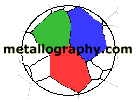
Gray Iron
As an example, Figure 11 shows a flake graphite specimen (see
Table 1) etched with 4% nital. The matrix is predominantly
pearlitic (colored tan, blue, and brown) and shows patches (arrow) of the
ternary eutectic (ferrite, cementite, and phosphide).

|
Microstructure of gray iron containing a pearlitic matrix and the ternary eutectic (4% nital, 250x). The larger white particles (arrow-C) are cementite while the adjacent area (arrow-fp) contains ferrite and iron phosphide. |
In comparison, Figure 12 shows the matrix structure of the specimen shown in Figure 2. The ternary phosphide is not present. The matrix is all fine pearlite.

|
Pearlitic matrix of the gray iron specimen shown in Fig. 2 etched with 4% nital, 100x. |
Besides the ternary ferrite-cementite-iron phosphide eutectic and the previously mentioned binary eutectics (austenite and cementite and austenite and graphite), it is possible to obtain a binary ferrite-iron phosphide eutectic in cast iron. Figure 13 shows the binary ferrite-iron phosphide psuedo- eutectic in the specimen previously shown in Figure 10, after etching with hot Murakami's reagent which colors the phosphide brown but does not color ferrite.

|
Gray iron specimen containing a binary ferrite-iron phosphide eutectic with the phosphide colored by the hot Murakami's etch, 100x. |
| Go to: | [FAQ] | [Home] | [Beginning of Article] |